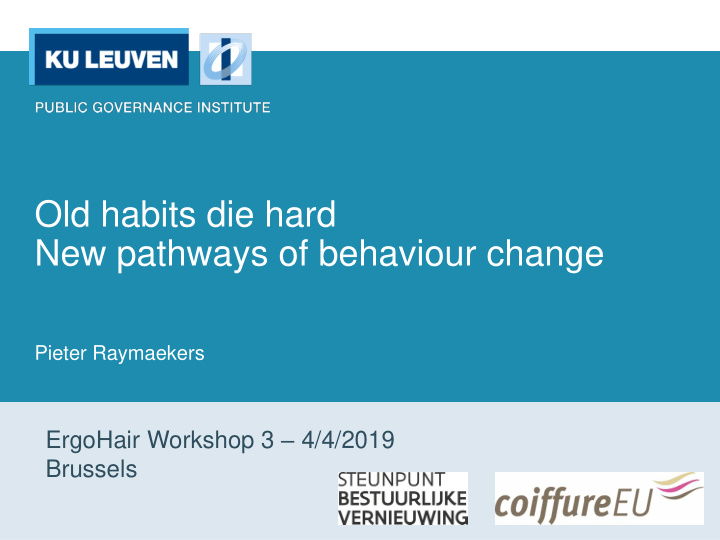



Old habits die hard New pathways of behaviour change Pieter Raymaekers ErgoHair Workshop 3 – 4/4/2019 Brussels
Structure Behaviour Nudges Taxonomy Criticism Newest pathways 2
1. Behaviour 3
Context and aim of the research 4
Two cognitive systems 5
6
Predictable irrationality 7
2. Nudges 8
Definition of nudging • Nudge = a light touch or push (in the ‘right’ direction) • Nudge = “any aspect of the choice architecture that alters people’s behavior in a predictable way without forbidding any options or significantly changing their economic incentives .” • Libertarian paternalism 9
LSD Chicago Schiphol Belgium Rotterdam – The Hague Copenhagen Stockholm Kent - UK 10
Policy instruments Source: Van den Doelen 1987: 53-57; Fobé 2014. Beleidsinstrumenten Positive Negative Prescriptions LEGAL Prohibitions Licenses, permits Regulatory ECONOMIC Subsidies, grants Taxes, user chargers Financial Information Propaganda COMMUNICATION education campaigns naming and shaming Persuasion E ducation Nudging & BI E ngineering E nforcement 11
Policy instruments 12
Map OECD (2018) https://twitter.com/faisal_naru/status/1027162896340578304 13
3. Taxonomy 14
Methodology of nudges 15
Simplification and Changes to the framing of physical information environment Taxonomy Changes to the The use of social default policy norms 16
1. Simplification and framing of information 17
2. Changes to the physical environment 18
3. Changes to the default option OPT IN OPT OUT Johnson & Goldstein (2003) ORGAANDONATIE 19
4. The use of social norms 20
4. The use of social norms The Opower Home Energy Reports 21
4. Criticism 22
Criticism on nudging • Lack of transparency • Patronizing and manipulative • From democracy to technocracy • Effectiveness and cost efficiency • Short versus long term • Context-dependent • Old wine in new bottles • Who’s nudging the nudgers? RMO (2014) 23
Hansen & Jespersen, Nudge and the Manipulation of Choice, 2013 Manipulation? 24
5. Newest pathways 25
Theory of planned behaviour Icek Ajzen 26
Newest pathways Social identity construction (Mols et al, 2015) Boosts (Hertwig & Grüne-Yanoffs, 2016) Educated nudges (Sunstein, 2016) Nudge plus (John, 2009, 2011, 2018) 27
A dual strategy to conclude Addressing the rational dimension of behaviour Eg. better informed, cost/ benefit ratio Traditional instruments Harnessing the unconscious dimension of behaviour Eg. biases and heuristics Behavioural Insights & Nudging 28
Thank you for your attention!
Recommend
More recommend